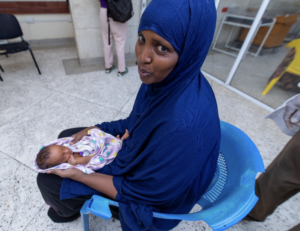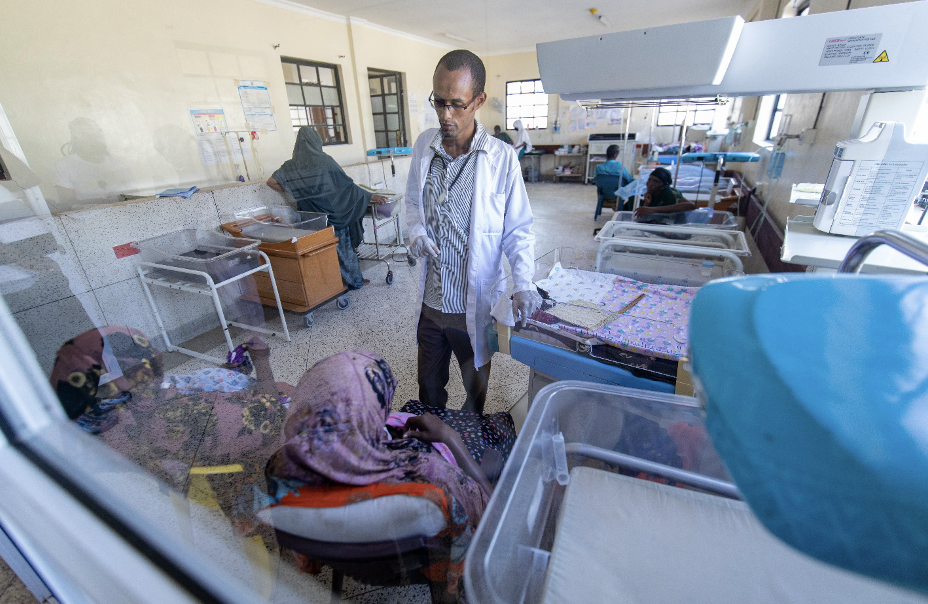During the 32nd week of her pregnancy, Halima Mohammed went into labor and was rushed to the Garissa Level 5 Hospital where she delivered a son. Hudheifa, whose name means “Companion of the Prophet” in Arabic, developed severe Respiratory Distress Syndrome. The condition arises in premature babies whose lungs have not fully developed and cannot provide enough oxygen for them.

I started crying because I was not sure he would live. He was so small and could not suckle; but Dr Abdirahman and the nurses assured me that he would be okay.”
Halima Mohammed
The nurses and Abdirahman Adnan, a pediatric clinician at Garissa´s Neonatal Intensive Care Unit (NICU), prescribed medical oxygen as a fundamental component of the treatment to save Hudheifa’s life. The clinicians assured the distraught mother that the hospital had a steady, uninterrupted supply of oxygen and that the health providers in the newborn unit had been trained to properly administer the oxygen and basic emergency care. Garissa is one of the five hospitals in Kenya that received support from the US Agency for International Development (USAID) in response to the COVID-19 pandemic, including the donation of a Pressure Swing Adsorption (PSA) oxygen production plant and technical assistance on the management and provision of oxygen therapy by the Reaching Impact, Saturation and Epidemic Control (RISE) project, implemented by Jhpiego, in partnership with PSM/Chemonics. USAID also provided the facilities with
commodities for both oxygen delivery to patients and maintenance of the plant for effective response to COVID-19 among other emergencies that require oxygen supplementation.
The PSA oxygen generating plant can provide 283 litres of oxygen per minute, which is able to fill 10 cylinders of 50kg in 24 hours and serve patients like baby Hudheifa who represent 10 to 15% of all pediatric admissions in healthcare facilities. With the installation of the plant, the facility has been able to adequately meet its oxygen needs. Additionally, the facility shares the filled cylinders with other health facilities whose patients need oxygen.
“With the knowledge gained from the Basic Emergency Care course, it was easy. Hudheifa was treated with Continuous Positive Airway Pressure, (CPAP), where the steady flow of air with oxygen coming in through the tubes from the machines keeps enough pressure in the lungs to prevent the air sacs from collapsing after each breath, until Hudheifa could breathe on his own,” Mr. Abdirahman explained.
Eleven days later, Hudheifa was weaned off oxygen and could be fed by the mother with expressed breast milk using a cup and spoon.
Garissa, an expansive county of 45,000 square kilometers—almost the size of the state of New York— did not have a source of oxygen, an essential medicine used to care for severely ill patients at all levels of the healthcare system, including: surgery, trauma, asthma, pneumonia, critical care and/or maternity and pediatric wards. This deficiency contributes to the county’s maternal mortality of 642 deaths per 100,000 live births, the highest in Kenya. Apart from the county’s 1 million population, it also holds the highest number of refugees in Kenya. The County’s Executive Committee Member (CEC) in charge of health, Ahmednadhir Omar, said the county spent as much as KSH 6,000,000 or $42,254 annually and KSH 500,00 or $3,521 monthly purchasing oxygen from a source in Nairobi, more than 300 kilometers away. This created a financial strain on the cash-strapped county as builds its health infrastructure.
Severe respiratory distress, and other forms of hypoxia, can be difficult to treat if providers are not trained on the best techniques and proper oxygen dosing. Evidence-based oxygen titration and weaning need to be mastered to ensure proper dosage for a patient’s age and weight. As an example, over-administration of oxygen can lead to oxygen toxicity and organ damage, including blindness. To address this gap in clinician knowledge, RISE trained 12 medical officers, nurses, and anesthetists from Garissa County Referral Hospital in Basic Emergency Care (BEC) and rational use of oxygen.

Before the training in BEC, nurses always had to wait until a doctor was available to intubate a severely sick child, losing valuable time that the child didn’t have to spare. The neonatal period – the first 28 days of life – is the most vulnerable time for a child’s survival. According to KDHS 2022, neonatal deaths account for 66% of infant deaths, partly due to the delicate care that neonates need. Rithwan Yusug, a nurse at the Garissa facility who received the RISE training and took care of Hudheifa, said, “I have learned to intubate, resuscitate and administer oxygen to neonates, and that is really important.”
Through the COVID-19 technical assistance, Nurse Rithwan said that she also learned how to use equipment to administer oxygen. She acquired knowledge on various instruments, including a pulse oximeter, which is a non-invasive tool. This device is attached to the patient’s finger using a clip and effectively calculates the blood oxygen saturation level, indicating the percentage of oxygenated hemoglobin in the blood. The results are shown on a monitor along with the patient’s pulse rate. The device emits an audible beep at concentrations below 94% which signals the healthcare providers to action, shortening the turn-around time. The correct use and interpretation of the results is of most importance as a third of the neonates who die in the facility present with asphyxia— when a child is deprived of oxygen during birth or immediately after. To save these children, the clinicians need to administer oxygen immediately after birth in an evidence-based manner and need to interpret the oxygen level results obtained precisely.
Through the COVID-19 response, RISE has supported the strengthening of the oxygen ecosystem by working with PSM in the installation and operation of five PSA oxygen production plants and building capacity in 98 health facilities. The life-saving training in BEC and the rational use of oxygen has been delivered to 223 additional health care providers in 13 counties across the country.



